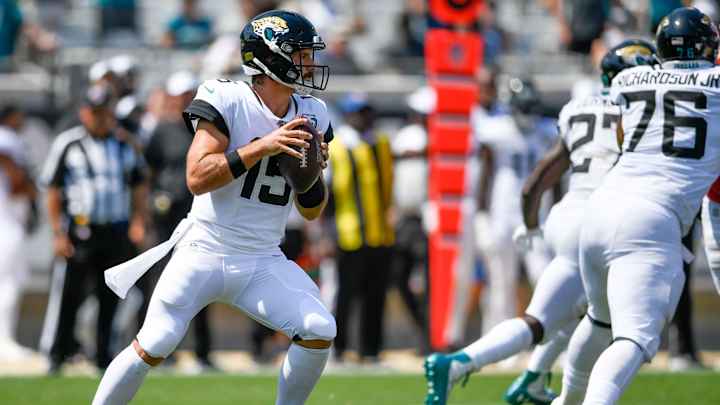What Do the Numbers Say About How Gardner Minshew Compared to Other Rookie QBs?

There were 11 quarterbacks selected in the 2019 NFL Draft, five of which attempted at least 150 passes last season. Of those quarterbacks, four were selected in the top-50 with the lone exception being Jacksonville Jaguars sixth-round pick Gardner Minshew.
Minshew was drafted to back up newly signed quarterback Nick Foles, but Minshew ended up ranking second among all rookie quarterbacks in games played and pass attempts behind only No. 1 overall pick Kyler Murray, giving Minshew more experience than most of his fellow rookie passers.
Murray eventually won Offensive Rookie of the Year largely as a result of more national attention and more cumulative statistics, but Minshew made his own mark. Below is an overview of how the five aforementioned rookie quarterbacks performed in terms of standard statistics via Pro Football Reference.
Gardner Minshew’s 2019 statistics compared to fellow rookie qbs with 150+ pass attempts pic.twitter.com/u1klaNDsMR
— Gus Logue (@gus_logue) June 23, 2020
Minshew ranked second in games played, completions, attempts, passing yards and passing touchdowns. He ranked first in yards per attempt and passer rating but fourth in completion percentage.
Standard statistics can provide a brief overview of player performance, but often fail to tell the full story. Advanced statistics are generally a better way to evaluate player performance, partly because it adjusts for playing time but mostly because it includes more context.
For example, a first-down running back screen that is caught at the line of scrimmage and then taken 80 yards for a touchdown would have a large effect on the quarterback’s standard statistics. But it likely wouldn’t be as effective on advanced statistics, for good reason, as the quarterback just made a short, one-read throw of minimal difficulty. On the other hand, an 80-yard touchdown that traveled 25 yards in the air on third down would be deemed more valuable by advanced statistics, even though the result of the play is the same, because the latter throw is almost certainly more difficult.
Here are six advanced statistics (with links to fuller explanations) that are generally better representations of quarterback performance than the standard statistics in the previous chart.
-Expected Points Added (EPA) per play
-Next Gen Stats’ Completion Percentage Over Expected (CPOE)
-Pro Football Focus (PFF) grade
-Sports Info Solutions’ Total Points Earned (TPE) per play
-ESPN’s Total Quarterback Rating (QBR)
-Football Outsiders’ Defense-adjusted Value Over Average (DVOA)
The chart below illustrates the 2019 rookie quarterbacks’ performances in these statistics. The composite ranking is the player’s average rank in the six metrics among 38 quarterbacks with at least 150 pass attempts last season.
Gardner Minshew’s 2019 advanced statistics compared to fellow rookie qbs with 150+ pass attempts
— Gus Logue (@gus_logue) June 23, 2020
Composite ranking is average effiency rank among all qbs with 150+ pass attempts (38) pic.twitter.com/M0bi4voxQX
Minshew ranked 27th among 38 quarterbacks in the NFL last season in terms of overall efficiency, and above only Dwayne Haskins among the five featured rookie quarterbacks. He ranked no better than 21st overall in each specific metric.
Minshew’s best metric was PFF grade, in which he ranked 21st. It’s difficult to specify exactly why this was his most successful statistic, but it’s partly due to his success on deep throws. On passes 20-plus yards downfield, Minshew ranked first in passer rating and third in PFF grade. Minshew also finished with the 19th highest rate of plays deemed turnover-worthy by PFF, which is adequate for a rookie.
Minshew’s worst metric was CPOE, in which he ranked 37th. He graded poorly in this specific statistic because his below-average accuracy (in which he ranked 27th per PFF metrics) resulted in a below-average completion percentage (32nd), despite a below-average depth of target (27th) that theoretically would have resulted in shorter/easier throws.
To summarize, Minshew was inaccurate despite throwing short often. This was a major factor for many of his efficiency rankings, but especially CPOE.
It’s fair to mention Minshew’s poor environment as a factor for his underwhelming efficiency rankings, as he played behind a poor offensive line with subpar receivers and unexceptional coaching. But none of the other rookie quarterbacks necessarily had advantageous surroundings either: none had a receiving group ranked above-average in PFF receiving grade; only Murray and Lock had an offensive line ranked above-average in PFF pass blocking grade; and all but Murray will have a new play-caller in 2020.
Still, Minshew’s 2019 performance is remarkable. He played with the second-team offense all offseason and was thrown into action in Week 1 after Foles broke his collarbone midgame. And Minshew did earn the highest PFF Wins Above Replacement, which suggests that even if he wasn’t the most efficient rookie quarterback, he may have been the most valuable.
It should be mentioned that rookie quarterback performance generally doesn’t carry much predictive power. There is certainly more information out on the 2019 rookies now than there was a year ago, but career assumptions should not be made after a quarterback’s first NFL season.
For that reason, 2020 may be one of the most important seasons in recent team history, regardless of the win/loss column. If Minshew takes a sophomore leap and improves his efficiency, he may be the face of the franchise for the foreseeable future. If he doesn’t, it’s likely that the Jaguars will look for a new quarterback in the 2021 NFL Draft, which would make Minshew an afterthought of the 2019 quarterback class and yet another disappointing chapter of past Jacksonville quarterbacks.
